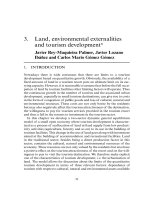THE ECONOMICS OF MONEY,BANKING, AND FINANCIAL MARKETS 466
Bạn đang xem bản rút gọn của tài liệu. Xem và tải ngay bản đầy đủ của tài liệu tại đây (54.31 KB, 1 trang )
434
PA R T V
Central Banking and the Conduct of Monetary Policy
policy rate; that is, the closer the overnight rate is to the target for the overnight
interest rate.
The Operating
Band for the
Overnight
Interest Rate
The Bank of Canada implements monetary policy by changing the policy rate, in
order to influence other short-term interest rates and the exchange rate. In fact, in
normal times the Bank s operational objective is to keep the overnight rate within
an operating band (also known as a channel or corridor) of 50 basis points (1/2
of 1%). Recently, however, and in response to the subprime financial crisis, the
Bank of Canada temporarily narrowed the operating band for the overnight interest rate to 25 basis points (1/4 of 1%).
As Figure 17-1 shows, the upper limit of the operating band defines the bank
rate ib. The bank rate is the interest rate the Bank charges LVTS participants that
require an overdraft loan (advance) to cover negative settlement balances on the
books of the Bank at the end of the banking day. The lower limit of the operating band is the rate the Bank pays to LVTS participants with positive settlement
balances at the end of the day. The midpoint of the operating band is the Bank
of Canada s target for the overnight rate, the operating target of the Bank of
Canada s monetary policy. When, for example, the operating band is from 3.5%
to 4.0%, the bank rate is 4.0%, the rate the Bank pays on deposits to LVTS participants is 3.5%, and the Bank s target for the overnight interest rate is 3.75%.
Since December 2000, the Bank of Canada has operated under a system of eight
fixed dates throughout the year for announcing any changes to the target and the
operating band for the overnight rate, and has reserved the option of acting between
the fixed dates in extraordinary circumstances. Early in the morning (at 9:00 a.m.)
on each of the eight announcement dates, the Bank of Canada announces the target and an operating band of 50 basis points for the overnight interest rate (see the
FYI box, Monetary Policy Implementation in the LVTS Environment ).
This channel/corridor system for setting the overnight interest rate is also used
by other central banks that, like the Bank of Canada, no longer have reserve
requirements for example, the Reserve Bank of Australia and the Reserve Bank
of New Zealand (see the FYI box, The Worldwide Decline in Reserve
Requirements and the Channel/Corridor System for Setting Interest Rates).
Overnight Rate,
ior
Bank Rate, ib
50-basis-point operating band
ib
0.50
Deficit (overdraft)
F I G U R E 17- 1
Surplus
Operating Band for the Overnight Interest Rate
Settlement
balance









